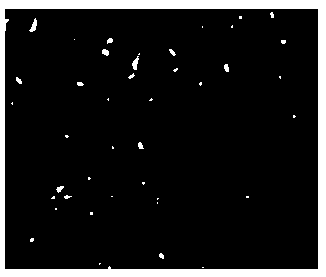Inducer of neutrophil extracellular traps and rapid induction method thereof
A technology of neutrophils and inducers, which is applied in the fields of biological detection and medical detection to achieve the effect of good repeatability and shortening of induction time
- Summary
- Abstract
- Description
- Claims
- Application Information
AI Technical Summary
Problems solved by technology
Method used
Image
Examples
Embodiment 1
[0074] (1) Separation of human peripheral blood neutrophils:
[0075] Take 5ml of fresh EDTA or citrate anticoagulated peripheral venous blood from the subjects, and dilute it with PBS at a ratio of 1:1. Add 10 ml separation liquid Polymorphprep to 50ml centrifuge tube TM , and then slowly drip the diluted anticoagulated blood along the tube wall into the upper layer of the separation solution. Then, it was centrifuged horizontally at 700 × g for 30 min at room temperature. After centrifugation, there are different layers, from top to bottom are serum layer, nuclear cell layer, separation liquid layer, white blood cell (the vast majority of which are neutrophils) layer and red blood cell layer. Use the capillary to extend into the white blood cell layer, and gently suck out all the white blood cells along the tube wall to a new EP tube. Then wash with 1ml PBS, centrifuge at 1500rpm for 10min, collect the precipitate, and repeat once. Cells were resuspended in RPMI medium c...
Embodiment 2
[0087] (1) Separation of human peripheral blood neutrophils:
[0088] With embodiment 1 step (1).
[0089] (2) Induce neutrophils to form NETs:
[0090] (2.1) Dilute the extracted neutrophils with RPMI medium containing 5% FBS and adjust to a cell density of 1 × 10 6 a / ml;
[0091] (2.2) Divide the cells into 5 × 10 5 The number of cells / well was inoculated into a 24-well plate covered with glass slides, 0.5 ml per well;
[0092] (2.3) Using IgG4, APD and lipopolysaccharide to induce neutrophils in stages, the specific process is as follows:
[0093] S1: Pretreated cells: Add IgG4 to the wells to make the final concentration 20nM, incubate at 37°C, 5%CO 2 Place the pretreated cells in the incubator for 30 minutes;
[0094] S2: Rapid induction: APD was added to the above pretreated solution with a final concentration of 10 nM. At the same time, the temperature was raised from 37°C to 40°C, incubated for 15 minutes, and then cooled to 38°C at a rate of 0.5°C per minute. ...
Embodiment 3
[0099] (1) Separation of human peripheral blood neutrophils:
[0100] With embodiment 2 step (1).
[0101] (2) Induce neutrophils to form NETs:
[0102] (2.1) Dilute the extracted neutrophils with RPMI medium containing 5% FBS and adjust to a cell density of 1 x 10 6 a / ml;
[0103] (2.2) Divide the cells into 5 × 10 5 The number of cells / well was inoculated into a 24-well plate covered with glass slides, 0.5 ml per well;
[0104] (2.3) Use IgG4, APD and lipopolysaccharide composite inducer to directly induce neutrophils, the specific process is: add IgG4, APD and lipopolysaccharide directly to the well at one time, so that the final concentrations are 20nM, 10nM, 30nM at 37°C, 5%CO 2 Cells were induced for 90 min in an incubator.
[0105] (3) Post-processing: Quantitative analysis and identification of NETs:
[0106] The operation method is the same as step (3) of Example 2, and the extracellular fiber network structure can be seen in confocal laser microscopy imaging....
PUM
 Login to View More
Login to View More Abstract
Description
Claims
Application Information
 Login to View More
Login to View More - R&D
- Intellectual Property
- Life Sciences
- Materials
- Tech Scout
- Unparalleled Data Quality
- Higher Quality Content
- 60% Fewer Hallucinations
Browse by: Latest US Patents, China's latest patents, Technical Efficacy Thesaurus, Application Domain, Technology Topic, Popular Technical Reports.
© 2025 PatSnap. All rights reserved.Legal|Privacy policy|Modern Slavery Act Transparency Statement|Sitemap|About US| Contact US: help@patsnap.com


